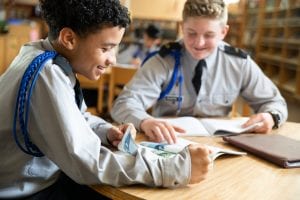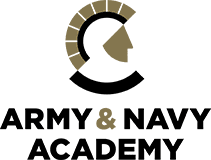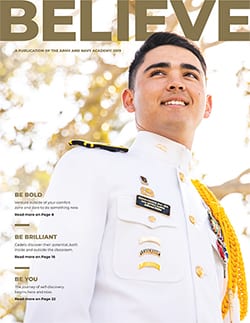 As a parent, are you wondering how to teach financial literacy to teenagers or whether schools should teach financial literacy? Ideally, financial literacy lessons should happen both at home and at school. As you know, money management is not only an essential skill for teens that can lead to financial stability, but it also empowers them to set goals and make wise decisions.
As a parent, are you wondering how to teach financial literacy to teenagers or whether schools should teach financial literacy? Ideally, financial literacy lessons should happen both at home and at school. As you know, money management is not only an essential skill for teens that can lead to financial stability, but it also empowers them to set goals and make wise decisions.
As a parent, you can do your part, but finding a private school that actually includes these kinds of life skills can be instrumental in your teen’s personal growth. If you’re considering a private school in San Diego County, Army and Navy Academy actually teaches high school students about finances within the context of their Leadership Education Training (LET) classes. .
This military school strongly believes that building a foundation in financial literacy can set teens up for success before they head off to college and later in life.
This school understands that a healthy relationship with money begins with some basics and it is never too early to learn the fundamentals. Middle schoolers and high schoolers should learn financial concepts that the U.S. FLEK highlights, including:
- Earn – Teach teens ways to earn money through jobs, internships, entrepreneurial ventures and other sources.
- Spend – Help teens develop plans on how to spend funds wisely against goals, as well as how to set up a checking account and use an ATM card.
- Save – Show teenagers how to save for expensive items such as: cars, phones, computers and learn how to set up a savings account.
- Invest – Model and demonstrate how to invest money wisely and see funds grow over time including: stocks, bonds and retirement accounts.
- Borrow – Instruct teens on the fundamentals of how to buy a first car and home, as well as how to manage loans. .
- Protect – Share information with teens about how to secure investment and bank accounts, monitor their FICO score, and actively check accounts.
Tips on Setting Up an Allowance
Allowances are typically handled by parents, but at boarding schools, students need to manage funds independently for bookstore and other expenses. Establishing an allowance introduces teens to the concepts of both earning and managing money if requirements are put into place. Teenagers need to have direct experience in handling finances and making wise spending decisions, which in turn, helps them appreciate the value of money earned through allowances.
Clubs and organizations, as well as home guidance can help students learn how to set up and use allowances thoughtfully. Here are some tips:
- Save a portion of income from various sources.
- Budget for items on their list of needs and wants.
- Making spending decisions in an informed and thoughtful manner.
Show Them How a Budget Works
When you show a teen how a budget works, they will have a lifelong skill to fall back on. High schoolers need to learn how to track their income and expenses to ensure they do not exceed their financial means. Budgeting is a practice that helps teenagers learn how to save, know where their money is being spent, as well as identify expenses where they can cut back. .
A simple budgeting exercise can involve:
- Listing all sources of income, such as allowance or part-time job earnings.
- Tracking all school and personal expenses should be recorded on a mobile device, spreadsheet or with a checkbook booklet. This ensures they know their balance.
Teach Them About Debt
Understanding debt is crucial for middle schoolers and high schoolers as they prepare for financial independence in college and life.. Financial literacy includes knowing about the different types of debt:
- Credit card debt – Understanding interest rates is essential.
- Student loans – Reading the fine print about payback plans and interest.
- Car Loans – Checking the terms of the loan, interest rate, and payoff schedule.
- Mortgages – Thinking ahead to a home purchase and how these loans work.
Teaching financial literacy naturally includes discussions about the impact of FICO scores and the impact on well-being and health. As you know, carrying debt can be quite stressful if not properly managed, so teens need to think carefully about their borrowing choices and map out careful plans for repayment of any debt.
Note: When teens begin to apply to college, get them involved in financial aid processes so they gain a solid understanding of student loan documents and the debt.
Discuss Cash vs. Credit
Cash vs. credit? To make smart money choices, teenage students need to know how and when to use cash versus credit. Good credit habits are essential as teens move toward adulthood, head off to college, and want to live independently.
When teaching financial literacy in school or at home to teens, emphasize the importance of maintaining a high credit score. Also, talk about future goals that depend on FICO scores such: such as lower interest rates on car loans, renting a place to live or eventually buying a home.
Good credit score habits we can teach teens at home and school include:
- Pay your bills on time by keeping a system that works well (choices include bank auto pay, or bill-pay lists on bank apps or receiving hard copies of bills).
- Pay the full balance on the statement every month to avoid interest charges.
- Keep track of expenses to avoid going over spending limits on a credit card.
- Avoid taking out multiple credit cards to track and keep all expenses on one credit card. It is often best to begin with debit cards so lessons are learned against accounts that will not impact FICO scores.
- Look for low interest rate cards, cash back, travel and other perks.
Examples of Delayed Gratification Financially
Teenagers are stimulated by lots of cultural pressures to spend and receive instant gratification, but learning how to delay gratification is a very valuable financial skill. Developing self-discipline, personal responsibility and goal-setting are essential to develop wise and productive spending habits.
Teaching financial literacy entails teaching teenagers to do the following:
- Save for expensive purchases – Saving for a travel experience, college expenses or first car are just a few examples where teens need to save.
- Avoid buying small items impulsively – Avoid expensive daily expenses like coffee, junk food, and clothes that add up quickly.
- Set financial goals – By setting goals, teens are more likely to stick to a budget and feel a sense of success when they buy an important item or experience.
- Create a plan to achieve the desired end goal – Follow the plan to hit a specific goal like going to a concert, buying a new computer, cell phone or other expensive items.
It is never too early to teach financial literacy, but we all must ensure teenagers know the basics of finances. Whether we teach these lessons at home or in the classroom, we are helping our youth become responsible citizens and leaders who are capable of leading productive lives. Teaching financial literacy to teens provides structure and motivation toward greater freedom and independence, both now and in the future.
Resources:
- The Complete Guide to Financial Literacy for Teens by Holly Sherman
- Government articles and resources on financial literacy
- 6 Real Money Lessons for Teens
- Teaching Kids About Money, Ages 14-16
Learn More About a Boarding School that Teaches Financial Literacy: Located on a beachfront campus in Southern California’s Carlsbad Village, Army and Navy Academy is a college preparatory school with boarding and day options. Geared exclusively for boys in grades 7-12, we are a model school for boys in middle school and high school and are ranked in the top five boarding schools in California.
Army & Navy Academy Admission Office:
Phone: 888-762-2338


